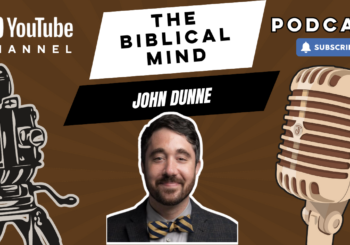A Pentecostal’s Biblical Reflections on the Asbury Revival
As a Pentecostal, I am familiar with revival language. It is common practice in my sphere to seek or pray for revival.
Soon after the Asbury revival started, I began to see accounts about it on social media. My wife attended the Brownsville Revival and encountered God in a powerful way, including healing from dyslexia and auditory processing disorder. So, after talking with my wife, we decided to make the long trek with our children to attend. If the event at Asbury was truly a revival, we did not want to miss it. If it turned out to be just a continuous worship service, we would have participated in a beautiful church gathering driven by hunger for the Lord. We didn’t see any drawbacks to this trip (except the long drive!).
Enjoying this article? Read more from The Biblical Mind.
What might the biblical authors make of the Asbury revival? From my perspective as a Pentecostal, I’ll start by considering the related terms of revival, outpouring, and awakening to provide a modified working definition and characteristics of revival. Next I’ll look at Luke 24:13–53 and Philippians 2:1–12 as important markers for revival and reformation. Finally, I’ll reflect on the Asbury revival in light of the biblical picture. I believe the features of the Asbury revival gave a glimpse of a genuine Christian faith that stirs hope for reformation where the effects of revival spread.
Defining Terms: Revival, Outpouring, and Awakening
The word “revival” carries a lot of baggage. From what I have gathered following online conversations, one of the controversies surrounding the Asbury revival regarded proper terminology. For some, revival requires a Pentecost-like mass conversion. For others, God’s presence and glory must be so palpable that people experience intense physiological effects, such as being laid out on the floor. Interestingly, Asbury University used “outpouring” and “spiritual renewal” to describe what occurred on campus. Its president, Dr. Kevin Brown, was unconcerned with the terms.
Whichever terms are used, they are generally synonymous. They all indicate religious renewal, including awakening to new life through justification, which is the work of God. Outpouring in biblical revival passages indicates conscious recognition of the Holy Spirit’s work, as seen in Isaiah 32:15–20, Joel 2:28–29, Peter’s appropriation of Joel in Acts 2:14–38, and Romans 5:5. Revival is inherently an outpouring of the Holy Spirit. As such, it is an outpouring of God’s love. In Augustine’s exposition of 1 John 4, he shows that abiding in love is the way to abide in God, and the knowledge of our abiding in God is made possible by the presence of the Holy Spirit. Our love for God and others, the sign of our abiding in God, is only possible because God first loved us in giving us the Spirit; our love is evidence of the presence of the Spirit. God’s outpoured love comes through the Holy Spirit (Romans 5:5).1Saint Augustine, The Trinity, ed. John E. Rotelle, O.S.A, trans. Edmund Hill, O.P. (Hyde Park: New City Press, 1991), 420–21. Hence, although the triune Godhead is love, Augustine calls the Spirit the “common charity” or the bond of love between the Father and the Son.2Saint Augustine, The Trinity, 418. Revival, outpouring, and awakening are thus synonyms to describe religious renewal effected by God through the Holy Spirit.
Such revival could happen within an individual. In my life, I had walked away from Christianity in high school. While serving in the US Navy, I sensed that God was drawing my attention. One morning after a night of my drunken revelry, the Holy Spirit powerfully convicted my sense of purpose and meaning in life, and I felt compelled to repent. I immediately drove home, and I experienced God’s outpoured love and was awakened to new life. However, we do not have such revival in mind when we reflect on the social phenomenon that we normally associate with revivals such as Asbury’s. Furthermore, revival often follows some crisis moment that confronts one with the need for repentance or a recognition of the need for God. In Scripture, we see these crisis moments throughout Judges, in Hezekiah’s response to the idolatry of his father Ahaz (2 Chr 28–29), and with the national idolatry and the discovery of the book of the Law during Josiah’s reign (2 Chr 34). Therefore, I will adopt the definition of revival in the Encyclopedia of Religious Revivals in America but with modification based on the reasons stated above: Revival is a corporate, intensely experiential event [my addition: effected by the work of God through the Holy Spirit in renewing the works of love for God and others, often in response to a crisis moment] that creates and renews religious feeling and expression in pronounced ways.3Michael J. McClymond, “Preface,” in Encyclopedia of Religious Revivals in America, ed. Michael J. McClymond (Westport: Greenwood Press, 2007), xix.
The Asbury revival meets this definition. It began in corporate chapel in response to a crisis moment, a challenge and call to love. According to testimonies, students lingered in prayer after chapel and even returned to chapel after class to seek the Lord in response to this call. Testimonials that followed, including ours, were ripe with experiential and affective elements. That it renewed religious feeling and expression is without question. Everyone recognized that the Spirit was at work, and the revival was filled with love for God and each other. The spirit of unity and peace was palpable.
Importantly, since revival is an outpouring of God’s love through the Holy Spirit and such love manifests in love for others (1 Jn 4:20–21), we must judge the Asbury revival based on its long-lasting manifestations of love. This means that the Asbury revival did not end with the ceasing of the services. Though the sensational parts of revivals get most of the coverage, the reverberations of revival have greater effect, perhaps even with little to no acknowledgment of their association with the initiating revival.
The Road to Emmaus and the Christological Hymn
I now turn to the Road to Emmaus story because it shares some of the traits of the Asbury revival and meets the definition of revival. I’ll then turn to the Christological hymn of Philippians 2 as a model of what should happen after revival.
In the Emmaus story, we are confronted with two traumatized and bewildered disciples. They had believed that Jesus was to be the one who would redeem Israel, only to have their hopes dashed by his execution. Yet, there was now testimony that Jesus was alive! After a good tongue lashing, Jesus explained to them all that the Hebrew Scriptures said about the Messiah. When they were nearing Emmaus, Jesus acted as if he intended to continue in his journey. The disciples urged him to stay with them, as is common in ancient hospitality but also because they desired to hear more about Jesus’ explanation of Scripture. It was not until Jesus broke bread and gave it to them, clearly an allusion to the Last Supper, that their eyes were opened to recognize him before his vanishing. Jesus appears again, this time to the eleven and other disciples. Interestingly, despite the verification of his physical resurrection, the disciples “were disbelieving and still wondering” (Lk 24:41).
Five observations can be made here. First, the disciples have a corporate and intense experience. For the disciples on the road, they exclaimed upon initially seeing the risen Jesus, “Were not our hearts burning within us while he was talking to us on the road, while he was opening the scriptures to us?” (Lk 24:32) Other disciples also have bewildered responses that later transform into joy. Second, the chapter clearly indicates Jesus’ love for the disciples and the world. Even his chastisement was motivated by his love. For he wanted his disciples to understand and participate in God’s cosmic plan. Thus, he acted to alleviate their fears and blessed them in his ascension.
Third, the recognition of Jesus and the understanding of God’s cosmic plan in Scripture were made possible by God’s opening their eyes and minds. For the disciples to become renewed in their trust, God visited them in their situation and sovereignly worked to equip them for participating in God’s mission. Fourth, Jesus equipped them to be witnesses of God’s cosmic plan and prepared them to receive the outpouring of God’s love and the animating power of the Holy Spirit that had anointed him in his earthly mission. In his human nature, Jesus’ anointing by the Spirit indicated God’s presence with him and the power through which he would bring about the kingdom of God.4Cornelis Van Der Kooi, This Incredibly Benevolent Force: The Holy Spirit in Reformed Theology and Spirituality (Grand Rapids: William B. Eerdmans Publishing Company, 2018), 24–25. The last two points reveal that revival is a sovereign work of God through the Holy Spirit.
Finally, we see that their revival led to renewed religious feeling and expression. In both occurrences, the expression of their newfound religious understanding manifest in witnessing. The two disciples quickly told others about their encounter with the risen Jesus. The rest are told that they are to proclaim repentance and forgiveness of sins to all the nations. They were also revived to experience joy, which was expressed in worship.
The disciples were recipients of God’s love. Their revival from trauma occurred because of God’s mercy. Importantly, their hearts were set aflame not because of some sensational manifestation but because they encountered, even unknowingly, the risen Jesus. Their other encounters were also not sensational, at least apart from meeting a once-dead man. They had Bible lessons and meals with Jesus. They then needed a time of preparation for the promised Holy Spirit.
Revival is God’s work. Though encounter with God can be intense, revival need not be accompanied by sensational manifestations. From my experience, the Asbury revival followed a similar pattern. When compared to other contemporary revivals, it was not sensational. Though there were testimonies of signs and wonders (our middle child was healed of long COVID; we received prophetic words in prayer, contents of which those who prayed for me would not have known; and there were several testimonies of being healed from trauma), they were discreet and not sensationalized. The focus was on the worship of Jesus. People’s hearts were also turned to one another in service. Peace and unity were visible in the atmosphere. Even though it was an intense experiential event, the Asbury revival characterized a self-emptying attitude that everyone exhibited toward one another. Simply, people were renewed to become more like Jesus as depicted in the Christological hymn of Philippians 2.
Philippians 2 pictures the essential characteristics of those who abide in God through the outpouring of the Spirit. The essential theme is to be like Jesus, which is to be humble in love toward one another. Being united with Christ through the Spirit should express in love, unity, selflessness, humility, compassion, and concern for others (Phil 2:2–4), which Jesus supremely modeled for us in his incarnation. The Christological hymn beautifully states that Christ Jesus,
Who, being in very nature God,
did not consider equality with God something to be used to his own advantage;
rather, he made himself nothing
by taking the very nature of a servant,
being made in human likeness.
And being found in appearance as a man,
he humbled himself
by becoming obedient to death—
even death on a cross (Phil 2:6–8).
After listing the character traits we should model, Paul exhorts Christians to continue working out their “salvation with fear and trembling” (Phil 2:12). For Paul, being conformed into the image of the Son by modeling these characteristics is sign of sanctification. Importantly, Paul does not separate sanctification from salvation. Sanctification is the continuation of our justification; they are two sides of the same coin.
According to Richard Lovelace, reformation and renewal are often interrelated: “Reformation grows out of awakened spiritual interest, and spiritual renewal seldom persists long without continuing reformation. This suggests that God has chosen to bless his church with the fullness of the Holy Spirit on the condition of its moving toward certain vital norms of health and witness.”5Richard F. Lovelace, Dynamics of Spiritual Life: An Evangelical Theology of Renewal (Downers Grove: Inter-Varsity Press, 1979), 52. Revival must reform people. Without this reformation, revival will be short-lived. In fact, change through reformation must become the “norms of health.” Also, the reformation of character is not purely a human effort. Though virtuous character development occurs through habitual repetition, the list of virtues in Galatian 5:22–24 show that virtues develop in synergistic cooperation with the Spirit. We crucify our flesh and are guided by the Spirit, and this relationship results in the fruit of the Spirit (Gal 5:22–23).
Reformation should follow revival, which takes time to realize, so judging a revival merely by the duration of its central gathering is questionable. Lovelace’s lengthy statement is thus fitting:
[F]allen human nature is fertile ground for a fleshly religiosity which is impressively ‘spiritual’ but ultimately rooted in self-love. High emotional experiences, effusive religious talk, and even praising God and experiencing love for God and man can be self-centered and self-motivated. In contrast to this, experiences of renewal which are genuinely from the Holy Spirit are God-centered in character, based on worship, an appreciation of God’s worth and grandeur divorced from self-interest. Such experiences create humility in the convert rather than pride and issue in the creation of a new spirit of meekness, gentleness, forgiveness and mercy. They leave the believer hungering and thirsting after righteousness instead of satiated with self-congratulation. Most important, their end result is the performance of works of mercy and justice.6Lovelace, Dynamics of Spiritual Life, 42. Italics mine.
What I witnessed at Asbury carried the hallmarks of a genuine renewal Lovelace described.
The Asbury Revival
While waiting a long time to enter the chapel, we recognized the peaceful atmosphere that surrounded everyone. The spirit of service was evident, as people served those in line, whether through an organization or as individuals. It seemed that there was no need among us. My wife commented a few times, “It’s like the early church.” When we finally made it inside, what was extraordinary about the revival was its ordinariness. There were no bright lights, fog machines, or ear-piercing music that are barriers to disabled people in many churches. Lights were not dimmed so that focus was only on the “leaders” on stage. Prominent were the throng of student singers in the front, the filled altar with prayer teams and those who received prayers, and the words displayed in the center, “Holiness unto the Lord.” Title and prestige were nowhere to be found. My wife discovered that a group that was handing out food outside was from a church only because she asked. The lyrics of all worship music were God-directed. Those who spoke in chapel only gave their names and not their titles. Missing were what Lovelace described as fleshly religiosity that is ultimately rooted in self-love. In its place was radical humility before the Lord.
Upon reflection, it was unsurprising that a revival begun with praying students and which emphasized the participation of Gen Zers would be so unassuming. Gen Z prizes authenticity. They have seen polished churches succumbing to moral controversies and generally not holding up to their professed beliefs and teachings. No amount of seeker-sensitive strategies will win over Gen Zers. And what they desire in their hearts is what God sovereignly brought at Asbury: an authentic, unassuming encounter with God that powerfully renewed the people’s faith and love.
I am hopeful for the revival’s fruits, not only because I am convinced that the revival was a sovereign work of the Lord but also because the Spirit seemed to have presented a beautiful, authentic expression of faith that powerfully impacted the gatherers, especially the Gen Zers. Though the revival event at Asbury ended, and the events begun at other places will also end, the real work of revival will now unfold: the synergistic work of sanctification. Revival and reformation go hand-in-hand.
I end with a challenge and a hope. Encounters with God can have powerful, immediate effects on people’s lives. However, we cannot underestimate the power of sin that tempts us to return to idolatry. It may be bewildering to see the Israelites continually return to apostasy after witnessing God’s deliverance until we recognize sin’s depravity at work. Though we are freed from the guilt of sin, we will not be rid of sin until the second coming of Jesus. And until we recognize the remaining power of sin and the necessary participation in God’s sanctifying work as part of our continual journey of salvation, revivals will be short-lived. Surely, some will have had a short, summer-camp like emotional high at Asbury. However, I have greater hope of the enduring fruit because revival is God’s sovereign and sanctifying work. We must participate in God’s kingdom work, but the kingdom of God will advance ultimately because of God. Therefore, even if we never hear of the enduring effects of the revival in individuals’ lives, we can be assured “that the one who began a good work among [us] will bring it to completion by the day of Jesus Christ” (Phil 1:6).
End Notes
1. Saint Augustine, The Trinity, ed. John E. Rotelle, O.S.A, trans. Edmund Hill, O.P. (Hyde Park: New City Press, 1991), 420–21.
2. Saint Augustine, The Trinity, 418.
3. Michael J. McClymond, “Preface,” in Encyclopedia of Religious Revivals in America, ed. Michael J. McClymond (Westport: Greenwood Press, 2007), xix.
4. Cornelis Van Der Kooi, This Incredibly Benevolent Force: The Holy Spirit in Reformed Theology and Spirituality (Grand Rapids: William B. Eerdmans Publishing Company, 2018), 24–25.
5. Richard F. Lovelace, Dynamics of Spiritual Life: An Evangelical Theology of Renewal (Downers Grove: Inter-Varsity Press, 1979), 52.
6. Lovelace, Dynamics of Spiritual Life, 42. Italics mine.
Image created by Rubner Durais
Did you enjoy this article? Check out The Biblical Mind podcast.





